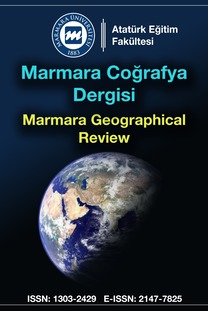BOĞAZKÖY BARAJ VE HES'İNDEN AKIŞAŞAĞIYA BIRAKILMASI GEREKEN ASGARİ SU MİKTARININ BULUNMASINA YÖNELİK BİR DEĞERLENDİRME: TENNANT VE AKIM SÜREKLİLİK YÖNTEMLERİ
Su kaynaklarından etkin ve verimli bir şekilde faydalanmak için akarsular üzerine inşa edilen su yapılarından akış aşağıya bırakılması gereken asgari su miktarının hesaplanması günümüzde büyük önem taşımaktadır. Çalışmada, Boğazköy Baraj ve HES'inden akış aşağıya bırakılması gereken asgari su miktarı hidrolojik verilere dayalı Tennant (1976) ve akım süreklilik yöntemi ile karşılaştırmalı olarak ele alınmıştır. Seçili yöntemler ile akarsu yatağında bulunması gereken asgari su miktarı hesaplanmıştır. Tennant (1976) yöntemine göre asgari su miktarı kurak dönemler için 1,34 m3/sn ve yağışlı dönemler için 1,69 m3/sn olarak belirlenmiştir. Akım süreklilik yöntemine göre Q70 6,59 m3/sn ve Q95 2,47 m/sn olarak hesaplanmıştır. Seçili yöntemlerden, çevresel akış için Q70 değerinin kullanılması daha uygundur.
Minimum Water Flow Assessment for Downstream of Boğazköy Dam and HEPP: Tennant and Flow Duration Methods
Nowadays, determination of minimum water flow from dams that are build on rivers, has a vital importance in order to utilize water resources effectively and efficiently. In this study, minimum water flow for Boğazköy Dam and HEPP is calculated based on two different hydrologic methods, namely flow duration curve and Tennant (1976) methods and they are compared with each other. As a result of current study, based on Tennant method, for raid periods minimum 1,34 m3/sec and for wet periods minimum 1,69 m3/sec water flow is calculated. Based on flow duration method Q70 and Q95 are calculated respectively 6,59 m3/sec and 2,47 m3/sec. Between selected methods, it is more convenient to use the Q70 for the environmental flow.
___
- Bayazıt, M. (1995). Hidroloji, İstambul Teknik Üniversitesi (İTÜ) İnşaat Fakültesi Yayınları, İstanbul.
- Caissie, D., El-Jabi, N. (1995). "Comparison and Regionalization of Hydrologically Based İnstream Flow Techniques in Atlantic Canada", Canadian Journal of Civil Engineering, sayı 22, s. 235-246.
- Karim, K., Gubbels, M. E., Goulter, I. C. (1995). "Review of Determination of iInstream Flow Requirements with Special Application to Australia", Water Resources Bulletin, sayı 31, s. 1063-1077.
- King, J. M., Tharme, R. E., Villers, M. S. (2008). Environmental Flow Assessments For Rivers: Manuel For Building Block Methodology, Water Research Commission (WRC), Gezina.
- Li, H.-e., Lin, Q.-c. (2010). Estimation and Guarantee Measures of Ecological Basic Flow in Weihe River. Bioinformatics and Özdemir, D. A., Karaca, Ö., Erkuş, M. K. (2007). Low Flow Calculation to Maintain Ecological Balance in Streams, Internationel River Basin Manegement Congress Book, Ankara.
- Pyrice, R. (2004). Hydrological Low Flof Indicates and Their Uses, Watershed Science Centre (WSC), Ontario. Smakhtin, V. U. (2001). "Low Flow Hydrology: A Review", Journal of Hydrology, sayı 240, s. 147-186.
- Smakhtin, V. U., ve Toulouse, M. (1998). "Relationships Between LowFlow Characteristics of South African Streams", Water SA, sayı 24(2), s. 107-112.
- Tennant, D. L. (1976). "Instream Flow Regimens for Fish, Wildlife, Recreation and Related Environmental Resources", Fisheries, Sayı 1, s. 6-10.
- Tharme, R. E. (2003). "A Global Prespective on Environmental Flow Assessment: Emergny Trends in The Devolopment and aplication of Environmental Flow Methodoligies For Rivers", River Research and Aplications, sayı 19, s. 397-441.
- Tharme, R. E., King, J. M. (1998). Development of the Building Block Methodology for Instream Flow Assessments and Supporting Research on the Effects of Different Magnitude Flows on Riverine Ecosystems, Water Research Commission (WRC), Cape Town.
- Ünver, Ö., Gamgam, H., Altunkaynak, B. (2013). Temel İstatistik Yöntemler, Seçkin Yayıncılık, Ankara.
- Yaşar, M., Baykan, N. O., Bülbül, A. (2011). Akışaşşağısına Bırakılması Gerekli Debi Yaklaşımları, II. Su Yapıları Sempozyumu, Diyarbakır.
- ISSN: 1303-2429
- Yayın Aralığı: Yılda 2 Sayı
- Başlangıç: 1997
- Yayıncı: Marmara Üniversitesi
Sayıdaki Diğer Makaleler
Nihal BALOĞLU UĞURLU, Elif ALADAĞ
TÜRKİYE'DE HABER KANALLARINDA HARİTA KULLANIMI
İSTANBUL ADALARI'NDA BEŞERİ ORTAM KOŞULLARINA AİT SORUNLAR VE YÖNETİMİ
Nuriye GARİPAĞAOĞLU, Sibel ÖZCAN
TÜRKİYE'DE İLÇELERİN VE 2012 YILI İLÇE NÜFUSLARININ YÜKSEKLİK VE KIYI YAKINLIĞINA GÖRE ANALİZİ
